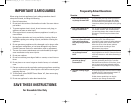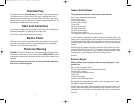
98
User Maintenance Instructions
CAUTION: To avoid accidental burns, allow your Grilling Machine to
cool thoroughly before cleaning.
1. Before cleaning, unplug the appliance from the wall outlet and allow
to cool.
CAUTION: To avoid any sparks at the outlet while disconnecting plug,
make sure the ON/OFF Power Button is off "--" before disconnecting the
plug from the outlet.
2. Inside cleaning: Place the Drip Tray under the front of the Grilling
Machine. Using the specially designed Spatula, scrape off any
excess fat and food particles. Run-off will drip into the Drip Tray.
Wipe the plates with the George Foreman specially designed Grill
Sponge.
3. Empty the Drip Tray and wash with warm soapy water. The Grilling
Plates may be removed from the appliance by pulling out on the
Grilling Plate Release Handles. Wash in warm, soapy water, rinse
and dry thoroughly. Reinstall the Grilling Plates, making sure they are
securely attached to the appliance. The removable Grilling Plates are
also dishwasher safe. After washing the Plates in the dishwasher,
wipe the uncoated side with a dry towel to prevent discoloration.
Dishwasher detergent may cause oxidation on the uncoated side of
the cooking plate. This is not harmful and can be wiped off with a
damp towel.
4. Stubborn build-up: Use the scouring side of the Grill Sponge to clean
the plates.
5. Outside cleaning: Wipe with a warm, wet sponge and dry with a soft,
dry cloth.
6. To clean the Bun Warmer surface, simply wipe with a clean, damp
cloth or sponge. Do not use harsh or abrasive cleaners!
7. Do not use steel wool, scouring pads, or abrasive cleaners on any
part of the appliance.
8. DO NOT IMMERSE THE BODY OF THE APPLIANCE IN WATER OR
OTHER LIQUID.
9. Any servicing requiring disassembly other than the above cleaning
must be performed by a qualified electrician.
10. Make sure to hold the top cover (Lid) by hand while cleaning to pre-
vent accidental closing and injury.
Suggested Cooking Chart
Rare Medium Well
(145˚F)* (160˚F)* (170˚F)*
Salmon Filet (1 1/2" thick) 7 min. 8 min. 9 min.
Talapia Fish (3/4" thick) 3 min. 4 min. 5 min.
Tuna Steak (1" thick) 6 min. 7 min. 8 min.
White Fish (1" thick) 7 min. 8 min. 9 min.
Shrimp, split with shell 2 min. 2
1
/
2
min.
4 oz. Turkey Burgers 6
1
/
2
min.
8 oz. Turkey Burgers 7
1
/
2
min.
Pork Loin (1/2" thick) 5 min. 7 min.
4 oz. Burgers 5 min. 6 min.
8 oz. Burgers 10 min. 11 min.
Chicken Breast 9 min.
(boneless/skinless)
Link Sausage 5 min. 6 min.
Sliced Sausage (1/2" thick) 5 min. 6 min.
Fajita Beef (1/2" thick slices) 1 min. 1
1
/
2
min. 2 min.
Rib Eye (1/2" thick) 3
1
/
2
min. 4
1
/
2
min. 5
1
/
2
min.
NY Strip (3/4" thick) 4 min. 5 min. 6 min.
Bratwurst 8 min. 10 min.
Frankfurter 5 min. 7 min.
Onions and Peppers 4 min. 5 min.
(1/2" thick, toss with olive oil)
NOTE: Most meats were 1" thick. These are recommended guidelines
only. Personal taste and thickness of cut may vary cooking times.
Always check for doneness and always use fresh, refrigerated foods.
PLEASE NOTE: The USDA recommends that meats such as beef and lamb,
etc. should be cooked to an internal temperature of 145˚F. Pork should be
cooked to an internal temperature of 160˚F and poultry products should be
cooked to an internal temperature of 170˚F - 180˚F to be sure any harmful
bacteria has been killed. When reheating meat/poultry products, they
should also be cooked to an internal temperature of 165˚F.
*Internal Food Temperatures
GRP4BWTMR/P/W/B_IB_11-3-05 3/12/05 5:02 PM Page 15


















